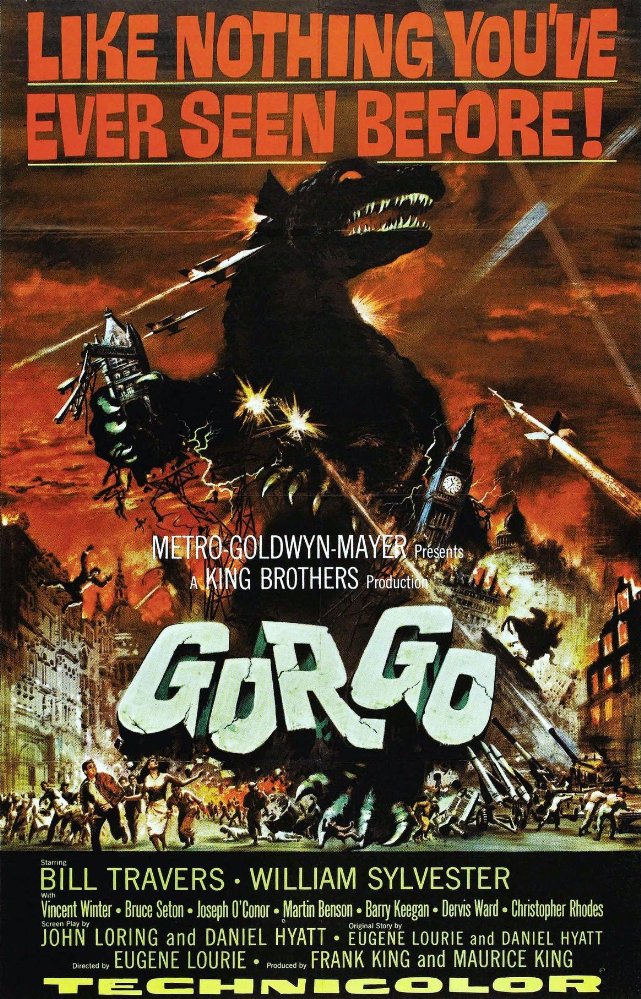Previous FilmGog
Next FilmGrizzly
Gorgo 1961
 | Greedy sailors capture a giant lizard off the coast of Ireland and sell it to a London circus. Then its mother shows up. |
The Cast
| Bill Travers | - | Joe |
| William Sylvester | - | Sam |
| Vincent Winter | - | Sean |
| Christopher Rhodes | - | McCartin |
| Joseph O'Conor | - | Prof. Hendricks |
| Bruce Seton | - | Prof. Flaherty |
| Martin Benson | - | Dorkin |
| Maurice Kaufmann | - | Radio Reporter |
Film Trivia
Eugène Lourié later acquired a 35mm print of the movie for private use and cut out all the stock footage military shots.
Scenes in which the baby Gorgo is driven through London were shot on a Sunday morning, which meant hardly anyone was in the streets. This was then explained away by a "TV announcer" who said that people were told to stay indoors.
The film was originally set in Japan. Later, the King Brothers and Eugène Lourié thought of setting it in Paris, but that would have meant the monster would have had to wade about 100 miles up the Seine to get to the city. Finally, the location was changed to Ireland and England.
The original script had no military action indicated. Director Eugène Lourié argued that gunfire would kill a beast, no matter how big. The King Brothers wanted guns and they got them.
The concept for the British poster art and lobby cards was that the face of Gorgo was not revealed. The idea is based on the line of dialogue in the film from Martin Benson, that Gorgo's name is derived from the Gorgon sisters of Greek mythology. The sight of their faces would turn you to stone.
This was one of 15 films considered for an Academy Award for Special Effects.
When the film was being viewed by the British Board of Film Classification the occupants of the adjoining offices came in to complain about the noise.
Gene Simmons of KISS, a lifelong fan of monster movies, based the now-iconic design of his performing boots on Gorgo's head.
The film had its London Premiere on 27 October 1961 at the London Pavilion, the theater seen in the scene where Gorgo is being driven through Piccadilly Circus, and was double-billed with My World Dies Screaming (1958). It went on its suburban London release on the ABC circuit on 27 November 1961.
Aside from Japan, Paris, and finally the U.K., the producers were considering using Australia as the location, however, they decided that nobody would care if he attacked Australia and settled on the U.K..
Other than the extras, there are no females in the cast.
Although this was a British production, it had its world premiere in Japan in January 1961, nine months before it premiered in Britian.
The score was by famed Italian composer Angelo Francesco Lavagnino and played by the 125 piece Sinfonia of London.
When Gorgo is being driven through Piccadilly Circus the West End cinema London Pavilion is showing the Hammer version of The Mummy (1959).
The performer inside the monster costume was the puppet animator Bob Bura.
First film of Harvey Hall.
Opening credits prologue: The producers acknowledge the generous help and co-operation given by the Authorities and Public Services of both London, England and Dublin, Eire, which made this picture possible.
The ending was inspired by Eugène Lourié's daughter who cried at the end of the Behemoth the Sea Monster (1959) when the monster was killed. When this happened, he decided to let both monsters live.
Both the adult and baby monsters were portrayed by the same actor in the same monster suit. Sets and models of differing sizes, as well as varying sound designs of the monster's roars, were utilized to make it appear there are two monsters of dramatically differing size.